Accepted Scientific Name: Kalanchoe delagoensis Eckl. & Zeyh.
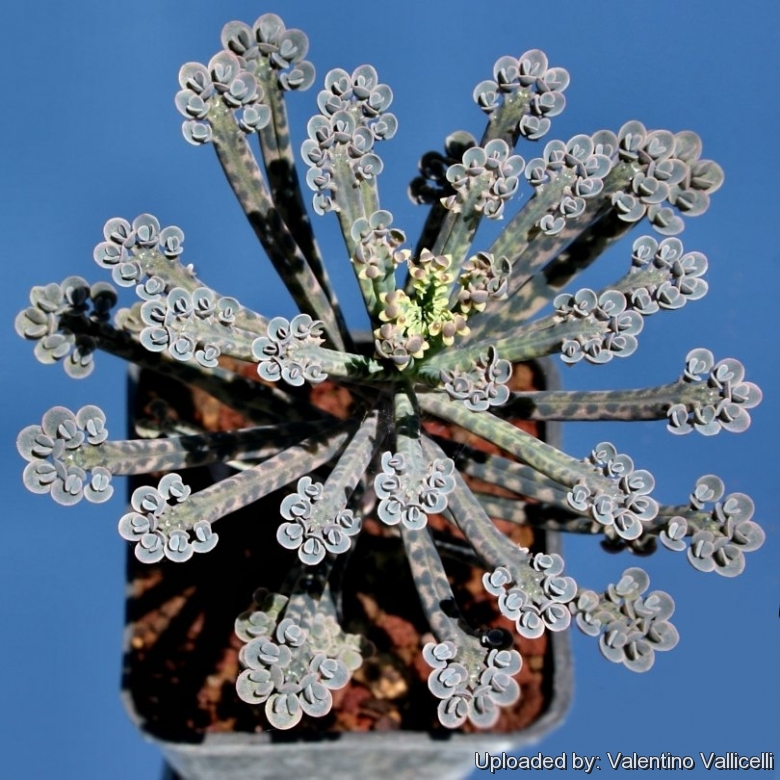
Bryophyllum delagoense (Kalanchoe delagoensis) Photo by: Valentino Vallicelli
"Mother of Thousands" This plant gets a lot of attention from visitors for its archetectural accents, its willingness to grow nearly anywhere, and the ease with which the babies can be pulled or scooped away where not wanted. They have to be fairly large to bloom, and a large potful of them in bloom can be spectacular.
Origin and Habitat: Madagascar.
Synonyms:
See all synonyms of Kalanchoe delagoensis
Common Names include:
ENGLISH: Mother of Millions, Mother of Thousands, Chandelier plant
CHINESE (中文): 洋吊钟
Description: The "Mother of Thousands" Kalanchoe delagoensisSN|29116]]SN|14418]] (Sym: Kalanchoe tubifloraSN|14420]]SN|14420]]) is a peculiar succulent species that reproduces via "plantlets" that grow on the ends of each leaf & drop off.... they fall into the dirt and grow from there. They grow everywhere, don't need dirt, they grow, among the spines of cacti, in orchid bark, between the leaves of bromeliads, in leaf litter on a cement patio, as well as in every pot within 15 m of the mother plant. Good thing they don't have nasty roots- they pull up out of the ground easily. The plant's capability for vegetative reproduction, its resistance to drought, and its popularity as a garden plant, have allowed the plant to become an invasive weed in places such as eastern Australia and many Pacific islands. In optimal conditions it grows as an annual/biannual and typically grows to about 1 m before blooming in the winter. Plants die back after blooming and new shoots can arise from the roots. Some similar plants that also produce an abundance of plantlets include Kalanchoe pinnataSN|14418]]SN|29116]] and Kalancboe daigremontiana. These are fun plants for kids to have and experiment with and provide a good lesson in plant propagation.
Leaves: Waxy with a rubber/plastic appearance, mottled with violet-brown leopard spots and frilled with plantlets, the leaves ray out in a snowflake shape from an upright central stem. Leaf width varies a lot, with plants in moist shade having wider, flat leaves and those in dry sand having the narrowest and most "tubular" leaves. The margins is entire except at their apices where there are five to seven teeth.
Flowers: Produces umbels of trumpet-shaped 2-3 cm long salmon to scarlet flowers that dangle in clusters from the top of the plant. They are very beautiful but hard to see.
Blooming season: Due to intense vegetative reproduction, this plant rarely blooms. But well grown larger specimens can flower profusely in winter, even with little or no water. The flowers last about 5 weeks so it is well worthwhile trying to get some.
Chromosome number: 2n = 68.
More...Notes: The plants hybridize easily with several others species especially with Kalanchoe daigremontiana and Kalanchoe rosei. The most common of its hybrid Kalanchoe x houghtonii (Kalanchoe daigremontiana × Kalanchoe delagoense) is much like K. daigremontiana but with narrower leaves. Both Kalanchoe delagoense and its hybrids easily escapes from garden and are noxious weeds in many tropical country. The plants spread by seeds and by plantlets that form on the edges of the leaves. They seem indestructible and are very difficult to eradicate as the seeds remain viable in the soil for many years.
Bibliography: Major references and further lectures
1) Forest & Kim Starr “Kalanchoe tubiflora (Chandelier plant”. Plants of Hawaii. <http://www.starrenvironmental.com>. Web. 27 Sep. 2014.
2) R. Fernandes “Flora Zambesiaca” FZ, Vol 7, 1983
3) James Cullen, Sabina G. Knees, H. Suzanne Cubey “The European Garden Flora Flowering Plants:A Manual for the Identification of Plants Cultivated in Europe, Both Out-of-Doors and Under Glass” Cambridge University Press, 11/ago/2011
4) Werner Rauh “The Wonderful World of Succulents: Cultivation and Description of Selected Succulent Plants Other Than Cacti” Smithsonian Institution Press, 1984
5) Hermann Jacobsen “A handbook of succulent plants: descriptions, synonyms, and cultural details for succulents other than Cactaceae, Volume 1” Blandford Press, 1960
6) Eggli, U. "The Illustrated Handbook of Succulent Plants; Crassulaceae." Berlin: Springer-Verlag. 2003
7) Wikipedia contributors. "Kalanchoe delagoensis." Wikipedia, The Free Encyclopedia. Wikipedia, The Free Encyclopedia, 11 Jul. 2014. Web. 22 Oct. 2014.
8) F. Friedmann: "Sur de nouveaux nombres chromosomiques dans le genre Kalanchoë (Crassulacées) à Madagascar." In: Candollea. Band 26, Nr. 1, S. 103-107, 1971
9) Reid V. Moran “Bryophyllum delagoense (Ecklon & Zeyher) Schinz [family CRASSULACEAE] Flora of North America” Vol 8 Magnoliophyta: Paeoniaceae to Ericaceae. Flora of North America Editorial Committee. 2009.
10) W. H. Harvey “Flora Capensis” Vol 2, page 327 1894
More...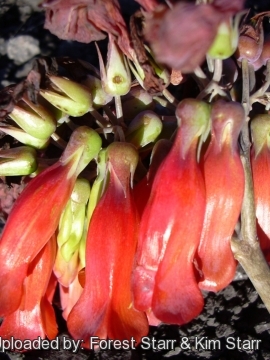 Flowers at Kanaio, Maui, Hawaii (USA). December 10, 2003. (Kalanchoe delagoensis) Photo by: Forest Starr & Kim Starr
Flowers at Kanaio, Maui, Hawaii (USA). December 10, 2003. (Kalanchoe delagoensis) Photo by: Forest Starr & Kim Starr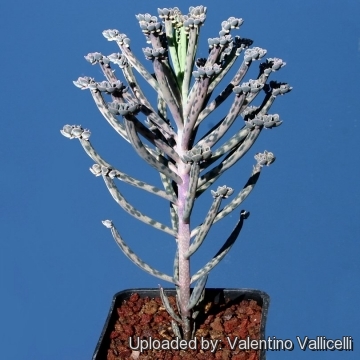 Bryophyllum delagoense (Kalanchoe delagoensis) Photo by: Valentino Vallicelli
Bryophyllum delagoense (Kalanchoe delagoensis) Photo by: Valentino Vallicelli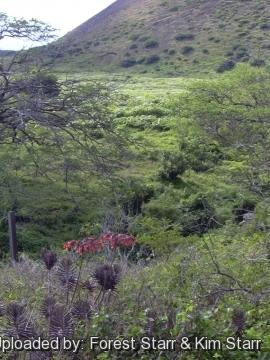 Flowering habit at Kanaio, Maui, Hawaii (USA). March 31, 2004. (Kalanchoe delagoensis) Photo by: Forest Starr & Kim Starr
Flowering habit at Kanaio, Maui, Hawaii (USA). March 31, 2004. (Kalanchoe delagoensis) Photo by: Forest Starr & Kim Starr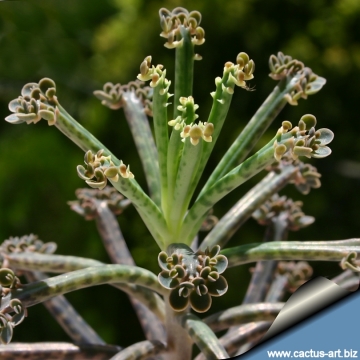 Bryophyllum delagoense (Kalanchoe delagoensis) Photo by: Cactus Art
Bryophyllum delagoense (Kalanchoe delagoensis) Photo by: Cactus Art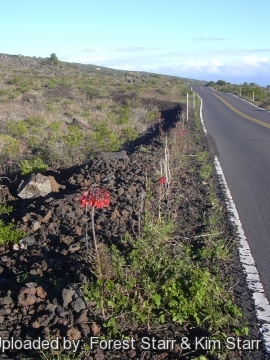 Flowering habit at Kanaio, Maui, Hawaii (USA). December 10, 2003. (Kalanchoe delagoensis) Photo by: Forest Starr & Kim Starr
Flowering habit at Kanaio, Maui, Hawaii (USA). December 10, 2003. (Kalanchoe delagoensis) Photo by: Forest Starr & Kim Starr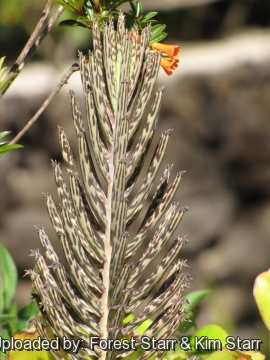 Leaves at Kula Botanical Garden, Maui, Hawaii (USA). March 07, 2011. (Kalanchoe delagoensis) Photo by: Forest Starr & Kim Starr
Leaves at Kula Botanical Garden, Maui, Hawaii (USA). March 07, 2011. (Kalanchoe delagoensis) Photo by: Forest Starr & Kim Starr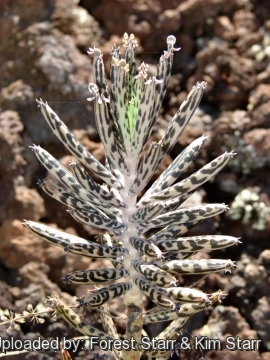 Habit at Kanaio, Maui, Hawaii (USA). March 20, 2007. (Kalanchoe delagoensis) Photo by: Forest Starr & Kim Starr
Habit at Kanaio, Maui, Hawaii (USA). March 20, 2007. (Kalanchoe delagoensis) Photo by: Forest Starr & Kim StarrSend a photo of this plant.The gallery now contains thousands of pictures, however it is possible to do even more. We are, of course, seeking photos of species not yet shown in the gallery but not only that, we are also looking for better pictures than those already present.
Read More... Cultivation and Propagation: This plant is almost indestructible, does not require any care... no care at all, it will grow. Sure it like water, but it is very drought tolerant... ... throw it on the trash piles and it just keeps growing and flowering.
Kalankoe delagoensis isn't hardy to severe freeze, but seem to tolerate everything else. Be careful with this species in outdoor culture, once it gets into a planting bed it is almost impossible to get rid of it, a few tiny plantlets seem to survive any attempt to weeding them out every time, and then they reproduce like crazy again.
These are very easy pot plants due to their drought tolerance, and in fact will grow in pretty deep shade without much trouble. Good thing they don't have nasty roots- they can be pulled or scooped away where not wanted. It need to be covered at least and housed in cold climates.
They are absolutely gorgeous as a cut flower in a tall stemmed green vase. However the flowers are produced only by healthy plants grown on optimal conditions:
1. It is best to grow them outside over the summer in an oversized pot so they grow large quickly with the extra fertilizing.
2. Repot them in Autumn and left outside in a bright but cool and dry location until first frost.
3. The cool temperature along with the shorter days at the back of the Solarium where the light levels are relatively low stimulate the production of abundant flower buds.
Propagation: This succulent produces its offspring at the tips of its tubular leaves but every part of it will root and grow new plants.
Warning: Parts of Kalankoe delagoensis is toxic, it contains a cardiac glycoside – daigremontianin. All members of Kalanchoe are toxic for livestock, birds, small animals and humans.
More...


















